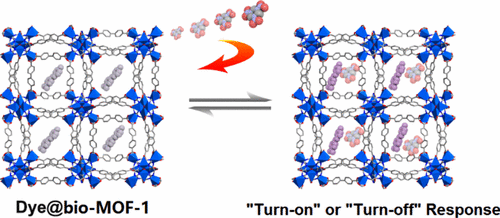当前位置:
X-MOL 学术
›
ACS Appl. Mater. Interfaces
›
论文详情
Our official English website, www.x-mol.net, welcomes your
feedback! (Note: you will need to create a separate account there.)
Dye@bio-MOF-1 Composite as a Dual-Emitting Platform for Enhanced Detection of a Wide Range of Explosive Molecules
ACS Applied Materials & Interfaces ( IF 8.3 ) Pub Date : 2017-05-25 00:00:00 , DOI: 10.1021/acsami.7b04172 Chen Wang 1 , Li Tian 1 , Wei Zhu 1, 2 , Shiqiang Wang 1 , Peng Wang 1 , Yun Liang 1 , Wanlin Zhang 1 , Hongwei Zhao 1 , Guangtao Li 1
ACS Applied Materials & Interfaces ( IF 8.3 ) Pub Date : 2017-05-25 00:00:00 , DOI: 10.1021/acsami.7b04172 Chen Wang 1 , Li Tian 1 , Wei Zhu 1, 2 , Shiqiang Wang 1 , Peng Wang 1 , Yun Liang 1 , Wanlin Zhang 1 , Hongwei Zhao 1 , Guangtao Li 1
Affiliation

|
By incorporating a cationic dye within a metal–organic framework (MOF) through an ion-exchange process, a responsive dye@bio-MOF-1 composite has been synthesized, serving as a dual-emitting platform for enhanced detection of different kinds of nitro-explosives, especially nitroalkanes, nitramines, and nitrate esters. The dye@bio-MOF-1 composite was constructed with free amines on their well-defined cavities, which is essential for the capture of explosives into their confined nanospace. It was observed that the encapsulation of explosives into the constructed dye@bio-MOF-1 composite could dramatically alter the luminescent properties of the dyes as well as the MOF skeletons owing to the size exclusivity and confinement-induced effect. For nitroaromatics, the dye@bio-MOF-1 composite exhibits turn-off responses via fluorescence quenching. Unexpectedly, the composite shows unique turn-on responses for aliphatic nitro-organics via confinement-induced enhancement, demonstrating enhanced ability to detecting different kinds of explosives selectively in aqueous solution. Furthermore, the dye@bio-MOF-1 film was facilely fabricated, making the chemical sensing more convenient and easier to realize the discrimination of the targeted explosives. The dual tunable responses indicate that dye@bio-MOF-1 composites are favorable materials for molecular sensing. On the basis of the host–guest properties of the constructed dye@bio-MOF-1 composite, our work can be further extended to sensing specific analytes with remarkable turn-on sensing properties, in particular those difficult to recognize with conventional methods.
中文翻译:

Dye @ bio-MOF-1复合材料作为双发射平台,可增强对各种爆炸性分子的检测
通过通过离子交换过程将阳离子染料掺入金属-有机骨架(MOF)中,已合成了响应型染料@ bio-MOF-1复合物,可作为双发射平台来增强对不同种类硝基的检测-爆炸物,尤其是硝基烷,硝胺和硝酸酯。染料@生物-MOF-1复合物是在其明确定义的空腔上构建有游离胺的,这对于将炸药捕获到其受限的纳米空间中至关重要。观察到,由于尺寸排他性和限制诱发效应,将炸药包封到所构建的染料@ bio-MOF-1复合物中可显着改变染料以及MOF骨架的发光性质。对于硝基芳族化合物,dye @ bio-MOF-1复合物通过荧光猝灭显示出关断响应。出乎意料的是,该复合物通过限制诱导的增强作用,对脂族硝基有机物表现出独特的开启响应,从而增强了选择性检测水溶液中不同种类炸药的能力。此外,简便地制备了yeer @ bio-MOF-1膜,使化学感应更方便,更容易实现对目标爆炸物的辨别。双重可调响应表明,染料@生物-MOF-1复合材料是用于分子传感的有利材料。根据所构建的dye @ bio-MOF-1复合材料的客体特性,我们的工作可以进一步扩展到检测具有显着开启感应特性的特定分析物,尤其是那些用常规方法难以识别的分析物。该复合物通过限制诱导的增强作用显示出对脂肪族硝基有机物的独特开启响应,表明增强了选择性检测水溶液中不同种类炸药的能力。此外,简便地制备了yeer @ bio-MOF-1膜,使化学感应更方便,更容易实现对目标爆炸物的辨别。双重可调响应表明,染料@生物-MOF-1复合材料是用于分子传感的有利材料。根据所构建的dye @ bio-MOF-1复合材料的客体特性,我们的工作可以进一步扩展到检测具有显着开启感应特性的特定分析物,尤其是那些用常规方法难以识别的分析物。该复合物通过限制诱导的增强作用显示出对脂肪族硝基有机物的独特开启响应,表明增强了选择性检测水溶液中不同种类炸药的能力。此外,简便地制备了yeer @ bio-MOF-1膜,使化学传感更方便,更容易实现对目标爆炸物的辨别。双重可调响应表明,染料@生物-MOF-1复合材料是用于分子传感的有利材料。根据所构建的dye @ bio-MOF-1复合材料的客体特性,我们的工作可以进一步扩展到检测具有显着开启感应特性的特定分析物,尤其是那些用常规方法难以识别的分析物。证明了增强的选择性检测水溶液中不同种类炸药的能力。此外,简便地制备了yeer @ bio-MOF-1膜,使化学感应更方便,更容易实现对目标爆炸物的辨别。双重可调响应表明,染料@生物-MOF-1复合材料是用于分子传感的有利材料。根据所构建的dye @ bio-MOF-1复合材料的客体特性,我们的工作可以进一步扩展到检测具有显着开启感应特性的特定分析物,尤其是那些用常规方法难以识别的分析物。证明了增强的选择性检测水溶液中不同种类炸药的能力。此外,简便地制备了yeer @ bio-MOF-1膜,使化学传感更方便,更容易实现对目标爆炸物的辨别。双重可调响应表明,染料@生物-MOF-1复合材料是用于分子传感的有利材料。根据已构建的dye @ bio-MOF-1复合材料的客体特性,我们的工作可以进一步扩展到检测具有显着开启感应特性的特定分析物,尤其是那些用常规方法难以识别的分析物。使化学感应更方便,更容易实现对目标爆炸物的辨别。双重可调响应表明,染料@生物-MOF-1复合材料是用于分子传感的有利材料。根据所构建的dye @ bio-MOF-1复合材料的客体特性,我们的工作可以进一步扩展到检测具有显着开启感应特性的特定分析物,尤其是那些用常规方法难以识别的分析物。使化学感应更方便,更容易实现对目标爆炸物的辨别。双重可调响应表明,染料@生物-MOF-1复合材料是用于分子传感的有利材料。根据所构建的dye @ bio-MOF-1复合材料的客体特性,我们的工作可以进一步扩展到检测具有显着开启感应特性的特定分析物,尤其是那些用常规方法难以识别的分析物。
更新日期:2017-06-06
中文翻译:

Dye @ bio-MOF-1复合材料作为双发射平台,可增强对各种爆炸性分子的检测
通过通过离子交换过程将阳离子染料掺入金属-有机骨架(MOF)中,已合成了响应型染料@ bio-MOF-1复合物,可作为双发射平台来增强对不同种类硝基的检测-爆炸物,尤其是硝基烷,硝胺和硝酸酯。染料@生物-MOF-1复合物是在其明确定义的空腔上构建有游离胺的,这对于将炸药捕获到其受限的纳米空间中至关重要。观察到,由于尺寸排他性和限制诱发效应,将炸药包封到所构建的染料@ bio-MOF-1复合物中可显着改变染料以及MOF骨架的发光性质。对于硝基芳族化合物,dye @ bio-MOF-1复合物通过荧光猝灭显示出关断响应。出乎意料的是,该复合物通过限制诱导的增强作用,对脂族硝基有机物表现出独特的开启响应,从而增强了选择性检测水溶液中不同种类炸药的能力。此外,简便地制备了yeer @ bio-MOF-1膜,使化学感应更方便,更容易实现对目标爆炸物的辨别。双重可调响应表明,染料@生物-MOF-1复合材料是用于分子传感的有利材料。根据所构建的dye @ bio-MOF-1复合材料的客体特性,我们的工作可以进一步扩展到检测具有显着开启感应特性的特定分析物,尤其是那些用常规方法难以识别的分析物。该复合物通过限制诱导的增强作用显示出对脂肪族硝基有机物的独特开启响应,表明增强了选择性检测水溶液中不同种类炸药的能力。此外,简便地制备了yeer @ bio-MOF-1膜,使化学感应更方便,更容易实现对目标爆炸物的辨别。双重可调响应表明,染料@生物-MOF-1复合材料是用于分子传感的有利材料。根据所构建的dye @ bio-MOF-1复合材料的客体特性,我们的工作可以进一步扩展到检测具有显着开启感应特性的特定分析物,尤其是那些用常规方法难以识别的分析物。该复合物通过限制诱导的增强作用显示出对脂肪族硝基有机物的独特开启响应,表明增强了选择性检测水溶液中不同种类炸药的能力。此外,简便地制备了yeer @ bio-MOF-1膜,使化学传感更方便,更容易实现对目标爆炸物的辨别。双重可调响应表明,染料@生物-MOF-1复合材料是用于分子传感的有利材料。根据所构建的dye @ bio-MOF-1复合材料的客体特性,我们的工作可以进一步扩展到检测具有显着开启感应特性的特定分析物,尤其是那些用常规方法难以识别的分析物。证明了增强的选择性检测水溶液中不同种类炸药的能力。此外,简便地制备了yeer @ bio-MOF-1膜,使化学感应更方便,更容易实现对目标爆炸物的辨别。双重可调响应表明,染料@生物-MOF-1复合材料是用于分子传感的有利材料。根据所构建的dye @ bio-MOF-1复合材料的客体特性,我们的工作可以进一步扩展到检测具有显着开启感应特性的特定分析物,尤其是那些用常规方法难以识别的分析物。证明了增强的选择性检测水溶液中不同种类炸药的能力。此外,简便地制备了yeer @ bio-MOF-1膜,使化学传感更方便,更容易实现对目标爆炸物的辨别。双重可调响应表明,染料@生物-MOF-1复合材料是用于分子传感的有利材料。根据已构建的dye @ bio-MOF-1复合材料的客体特性,我们的工作可以进一步扩展到检测具有显着开启感应特性的特定分析物,尤其是那些用常规方法难以识别的分析物。使化学感应更方便,更容易实现对目标爆炸物的辨别。双重可调响应表明,染料@生物-MOF-1复合材料是用于分子传感的有利材料。根据所构建的dye @ bio-MOF-1复合材料的客体特性,我们的工作可以进一步扩展到检测具有显着开启感应特性的特定分析物,尤其是那些用常规方法难以识别的分析物。使化学感应更方便,更容易实现对目标爆炸物的辨别。双重可调响应表明,染料@生物-MOF-1复合材料是用于分子传感的有利材料。根据所构建的dye @ bio-MOF-1复合材料的客体特性,我们的工作可以进一步扩展到检测具有显着开启感应特性的特定分析物,尤其是那些用常规方法难以识别的分析物。


















































 京公网安备 11010802027423号
京公网安备 11010802027423号